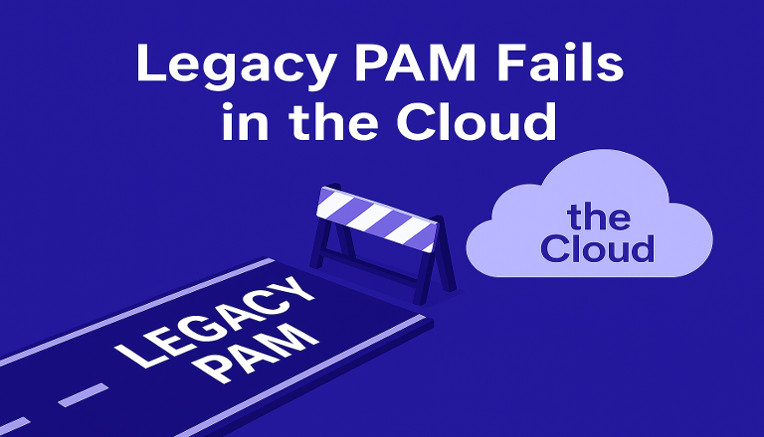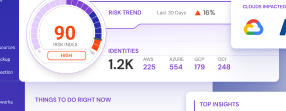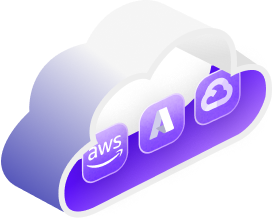Table of Contents

For years, organizations have tried to retrofit Privileged Access Management (PAM) tools into the public cloud. Jump boxes. Vaults. Session recording. Manual provisioning. None of it scales and it doesn’t scratch the surface of the cloud privilege problem.
Because cloud privilege isn’t about admin logins or shared root passwords.
It’s about permissions. Thousands of them. Scattered across humans, machines, AI agents, pipelines, third parties, and services. In AWS alone, there are more than 18,000 permissions. Of those, 1,095 are privileged; capable of creating backdoors, exfiltrating data, or disabling security controls.
Worse, 92% of identities with those privileged permissions never use them. Unseen by legacy PAM is a massive privilege attack surface, sitting idle and waiting to be exploited.
Privilege Lives in Permissions, Not ‘Admin Accounts’
You can’t manage privilege in the cloud by managing ‘admin access.’ Because in the cloud, privilege isn’t just tied to a login or a root account. It’s defined by what an identity can do via its permissions.
Traditional PAM solutions focus on securing who logs in. But in the cloud, the real risk lives deeper, in the thousands of granular permissions scattered across human and non-human identities alike.
Not all risk hides in obvious places like administrator access or wildcard (*) policies. Some of the most dangerous access paths start with seemingly harmless permissions.
For example, take iam:PutUserPolicy. One overlooked permission lets an identity attach new privileges to any user, granting themselves admin-level access or creating persistent backdoors without modifying any roles.
Or kms:PutKeyPolicy. It’s a standard permission for automation accounts. But when left unchecked, it can be used to rewrite a key policy and grant an external identity the ability to decrypt sensitive data in S3, RDS, or EBS.
These aren’t outliers. They’re examples of everyday privileged permissions that create real paths to compromise when privilege isn’t controlled at scale.
To secure cloud environments, you can’t just control who has access. You must control privileged permissions. That means managing permissions continuously, automatically, and across every identity. That’s the job ‘Cloud PAM’ must do.
Where Traditional PAM Breaks, and What Cloud PAM Must Do
Legacy PAM was built to manage access for a handful of human administrators in predictable, on-prem environments. Cloud-native environments demand something entirely different.
Most activity in the cloud comes from non-human identities (NHIs) and machine identities such as Lambda functions, containers, Terraform pipelines, and third-party integrations. These identities do not log in. They assume roles and operate through permissions defined in code.
They are often assigned broad, standard permission sets that grant far more access than necessary. And because traditional PAM cannot track or limit these privileges they remain unmonitored, with over-privileged identities, creating serious security risk.
Here is where traditional PAM breaks down and what a modern solution must deliver instead:
Legacy PAM vs. Modern Cloud-Native PAM
| Legacy PAM | Cloud-Native PAM (Cloud Permissions Firewall) |
| Built for static infrastructure | Built for dynamic, multi-cloud environments |
| Works only for human users | Covers humans, workloads, third parties, and AI |
| Secures login credentials | Secures permission-level access across all identities |
| Requires vaults, agents, and proxies | Uses native cloud controls, no extra infrastructure |
| Relies on log analysis for reactive protection | Blocks unnecessary privileges automatically, before a session begins |
| Adds friction to developer workflows | Enables privilege-on-demand and JIT access with zero disruption |
Cloud Permissions Firewall: Modern PAM Built for Cloud
Cloud PAM needs to control what identities can do, not just who can log in. Developers, workloads, pipelines, vendors, and AI agents all act on your environment, and each one needs clear, enforceable boundaries.
Sonrai’s Cloud Permissions Firewall does exactly that. It replaces manual oversight with automated enforcement, securing access at the privilege level and scaling across every identity class.
Here’s what Sonrai’s Cloud Permissions Firewall delivers:
Automates Least Privilege, Continuously
Tracks how privileges are actually used. Quarantines anything that sits idle. Removes unnecessary privilege and access without manual cleanup.
Denies New Privilege by Default
Blocks privileged permissions for new identities before they are used. Allows exceptions through an automated approval process.
Delivers Approvals at ChatOps Speed
Processes access requests directly in Slack or Teams in seconds. Logs every decision and action for full traceability.
Grants Just-in-Time Access for All Identities
Provides time-bound access to developers, services, automation, or AI. Removes standing privilege across the board.
Uses Native Cloud Controls
Enforces policies with the tools your cloud already provides. Skips proxies, avoids extra infrastructure, and preserves developer workflows.
Provides Built-In Auditability
Logs every request, approval, and action. Generates AI-powered session summaries that show who did what, when, and why, so your team doesn’t need to dig through raw logs.
The Bottom Line
Traditional PAM was built for a world of servers, logins, and manual oversight. That world is gone.
In the cloud, permissions drive privilege, and excess privileges drive risk.
Sonrai’s Cloud Permissions Firewall is the only Cloud PAM solution built for the speed, scale, and complexity of cloud. It removes standing privilege, protects every identity, and restores privilege only when it’s needed, with full auditability.
No agents. No proxies. No friction. Just secure, cloud-native control.
Ready to take control of cloud privilege?
Stop the sprawl. Start enforcing least privilege at cloud scale with Sonrai.



